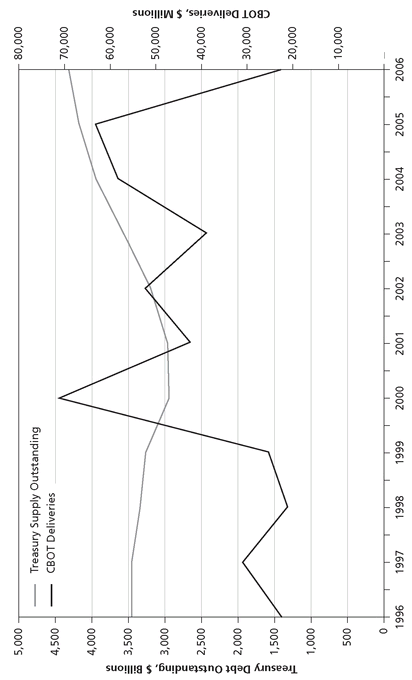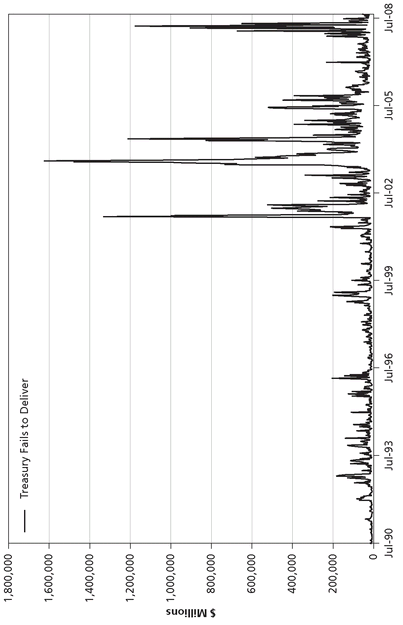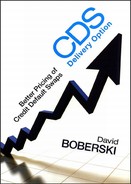5
The Squeeze
Before applying this methodology to credit default swaps, it is worth noting that, unlike in the credit derivatives market, deliveries in Treasury futures happen all the time. Treasury futures expire each quarter, and, although deliveries are typically not large, futures traders get to see them quite regularly. This regular observation has given Treasury futures basis traders a unique perspective from which to evaluate the delivery option in credit default swaps. Unlike an academic, who might have to sit in an office smoking a pipe to imagine the ramifications of delivery option, a trader sees it happening over and over again. Rather than having to guess about how a cheapest-to-deliver option might perform, futures traders can rely on their experience to develop an intuitive sense about what should or shouldn’t happen. Figure 5.1 illustrates the face value of notes and bonds that have gone through delivery since the start of trading 30-year Treasury futures contracts in the 1970s. As the notional value of Treasury futures has grown, so too has the face value of issues going through delivery. The gray line depicts the size of the Treasury market. It’s worth noting that the two markets have not grown in perfect tandem. Like all derivatives markets, the one for Treasury futures has grown more rapidly than the cash market on which it is based.
Figure 5.1 Deliveries at the CBOT vs. Issurance of Treasury Debt
Source: CFTC, CBOT

What happens when the notional value of contracts going through delivery is larger than the supply of the cheapest issue? Something no one ever intended.
If the notional value of contracts going through delivery is larger than the supply of the cheapest note in the basket, then there may be a “squeeze” on the issue. This situation could arise because of the underlying economics of a situation, where a broad array of users simply decide to take delivery for a myriad of uses and motivations, or it might happen because of a single individual manipulating the market. The term “squeeze” is quite negative in market circles, and implies that something is happening that probably shouldn’t. By design, physically settled contracts like Treasury futures and credit default swaps might be satisfied by more than one issue note in the cash market. If the cheapest note is not available, then of course the second-cheapest note is used. The whole ordeal is more expensive for holders of short contracts because they likely sold the notes when there was no fear of a two-issue delivery. Now, perhaps several months later, they are forced to buy back the notes once they have appreciated significantly, because it is now clear to the market that this second note will be needed for physical delivery. Put another way, the market is never quite sure about the size of deliveries going through the market, and traders know only about the size of the contracts they hold, and presumably there is no collusion between traders who are sharing information.
Certainly, traders who had anticipated a squeeze wouldn’t be willing to sell a contract at such a low price if they had known that the second-cheapest as well as the cheapest issue would be used to satisfy delivery. Conversely, the long would be willing to pay more in anticipation of receiving both the cheapest and second cheapest issues at settlement. There is nothing inherently evil about a multi-issue delivery, but it often catches people off guard and causes erratic spikes in the price of the contract. One of the problems with a squeeze is that it is unanticipated: when traders initially put on the position they may not have anticipated a squeeze and based the contract price on just the cheapest issue. However, as time goes on and delivery is imminent, it may become obvious that more than one issue is going to be delivered and that the contract price should be higher to account for the fact that the price of the issues is not the same—one is in fact higher. For example, in a two-issue delivery with equal amounts of each note, if the cheapest issue had a price of par, and the second-cheapest issue had a price of 102, then the fair price for the contract would be 101. If only the cheapest-to-deliver issue is going to be delivered then the fair price would be 100.
Figure 5.2 Fails Data
Source: Federal Reserve Bank of New York

There are also less than honorable ways to create a shortage of bonds in the market. One is to collude with other traders or investors to withhold issues from the financing market. Indeed, Treasury repo traders are under increasing scrutiny for their activities facilitating squeezes in the Treasury market, and a number of traders were fired from Wall Street repo desks for allegedly participating in the squeezes that rocked the Treasury market in 2005. Of course, there were four quarterly deliveries that year. The first three caused shortages in the cheapest-to-deliver note and a cascade of failed trades, meaning that the purchaser of the note is unable to take possession of the note from the seller, presumably because the seller was “failed to” himself and does not have possession of the note. The perception at the time was that the squeezes in the Treasury market in 2005 were not caused by a legitimate shortage of notes in the market, but rather by traders who intentionally failed to transfer notes that had been sold as if there were a massive delivery coming. Figure 5.2 illustrates the spike in fails during 2005 and shows that it was of the order of magnitude of a natural disaster or terror attack.
Due to physical delivery, the cash Treasury and futures markets are linked. The potential energy of the derivatives market to cause the underlying market to grind to a halt is not often appreciated, and there is this same risk in credit derivatives that call for physical delivery.
Making Mischief
Before applying our fair-value framework to credit default swaps, one might ask, “Why would anyone bother adding such a delivery option to a derivatives instrument, since it has the potential to cause such mischief?” Physical delivery has the enormous advantage of unequivocally linking the cash and derivatives market, and the potential for mischief is an added benefit.
A world in which everyone was clairvoyant and could perfectly predict the future would be a boring one to trade in. Uncertainty creates volatility, which creates opportunities for traders. As often as hedgers say they wish they could do away with volatility and speculation, they enjoy the liquidity provided by the rest of the participants in the market. Derivative design must strike a balance between clarity and complication, with the hope of attracting both hedgers and speculators. Divergent interests attract people to a product, but if the structure is too complex it will drive people away. This trade-off was visible in the Treasury squeezes of 2005, when many hedgers who were seeking less, not more, volatility by participating in the futures market were caught off guard by the behavior of the contract.
The reactions of different traders were interesting to watch. Some threw up their hands, said that what was going on wasn’t rational, and would not participate. Some traders attacked Wall Street. However, the vast majority of traders carefully considered how the design of the contract allowed for a range of possible behaviors. The most successful traders diligently studied the delivery option until they developed a pricing framework to explain the seemingly erratic price action. What does a spike in prices imply? That a proportion of the delivery will involve the second-cheapest issue. With this knowledge we can calculate exactly what the price of the contract implies about the expected split between the issues. Building a framework to extract meaning from market prices aids our decision-making, and the choice of whether or not to buy or sell becomes clearer.
Distorted Economics
Delivery option and physical settlement have led to some of the most distorted economic situations in the market, situations in which buying contracts can actually make their prices go down. In order to understand this, one has to step in during the final few days of delivery, when it seems inevitable that the notional value of contracts going through delivery will be larger than the amount outstanding of the cheapest-to-deliver issue.
During delivery month, in a positive carry environment, a few things happen. First, deliveries are usually made at the end of the month rather than the beginning, because the holders of the cash notes in a cash-and-carry arbitrage trade are earning interest every day, and it’s not in their interest to cut that short. Second, there are only about three weeks’ worth of trading days, since in the last week and a half of the month, trading in the expiring contract is not possible. This last trading day is the cliff that traders see looming in front of them in a possible squeeze situation—when they are trying to judge whether the open interest will drop enough every day so that all the outstanding contracts can be settled with the cheapest-to-deliver note, or whether there will be a multi-issue delivery. We will not examine the topic of a multi-issue delivery in credit default swaps, since this requires quite a bit more than understanding the fair-value methodology, but the operation of a multi-issue delivery in credit default swaps is parallel to the current example in Treasury futures. Navigating a squeeze is among the most difficult topics in finance, because it strains the very fabric of the market.
Suppose, then, that we are ten days away from the last trading day and that there are two hundred thousand contracts outstanding, representing the entire $20 billion face amount of the cheapest issue. (This example sounds a lot like a 10-year delivery. The numbers are roughly in line with the sizes of deliveries during the turbulent squeezes of 2005, when the general perception was that traders made several runs at trying to get the CBOT Treasury futures notes to settle to the prices of multiple issues.)
Is it possible that 100 percent of the cheapest issue, which is almost always an off-the-run note, will find its way into the hands of the holders of short contracts so that they can make deliveries to the long? This would be a single-issue delivery, and it’s what has happened more than 99 percent of the time in the decades since Treasury futures have traded. A single-issue delivery is simply what people expect to happen, and they price the contracts accordingly.
The Treasury market is liquid, but it’s not that liquid. There are certainly some traders who buy the issue with no intention of participating in arbitrage trades and who don’t care what the derivative value is. For example, a bank may have purchased the note and pledged it against a loan or certain deposits. In this circumstance, there is nothing the bank can do to take advantage of subsequent richening of the note, even if it wanted to, because of accounting rules. Also, if the bond is in a held-to-maturity account in order to avoid mark-to-market accounting, then it can’t come out of this portfolio unless the bank wants to lose the privilege of being able to hold such a portfolio. Notes can also be drained from the market if they are not lent out on repo in the financing market. Mutual funds and foreign central banks often are not able to take advantage of this facility. The end result of all of this is that the practical supply of notes in the market is surely not 100 percent of the face value of the notes outstanding. In most cases, it probably runs between 50 percent and 75 percent. Different issues may be above or below this mark, depending on idiosyncrasies of the particular note, but no one knows for sure.
How do we arrive at a situation where buying a contract can make its price go down? The whole point of a squeeze is to try to force the settlement of a greater notional value of contracts than exists in the practical supply, or “float,” of the cheapest issue. If it looks as if there is going to be a multi-issue delivery, the price of the contracts will increase to reflect this. This is why price will increase: In a multi-issue delivery, some of the deliveries will not be made with the cheapest issue—some of the second- and even third-cheapest issue will be in the mix. For example, if deliveries will be split 50/50 between the cheapest issue, priced at 100, and the second cheapest issue, priced at 102, then the expected price of the contracts should be 101. Forcing a squeeze has managed to add another full point to the profits of the holder of long contracts. It is worth noting that the calculation of the value of a multi-issue delivery depends on the relative price gap between issues that are being considered for delivery. If the prices we used were 100 and 106, a 50/50 delivery split would be more valuable than if the prices were 100 and 100.50.
However, what about the other side? For every long there is a short, and in this case the shorts are trying to break the squeeze since it is raising the price of the contract higher than they would like: they don’t want to have to buy a cash note at a higher price than the cheapest issue if they can avoid it. If they can change people’s perceptions about the likelihood of a multi-issue delivery, there is a chance that the price of the contract will go down. To do this, they must make it look as if there are fewer contracts going through delivery. If they unwind a small proportion of their short contracts, the open interest will drop, ideally enough that perceptions about the delivery will change. Specifically, we are interested in dropping open interest enough so that shorts will squeak by with making 100 percent of deliveries with the cheapest note. The options are fairly limited: all the holders of short contracts can do is buy them back!
Suppose that we are still staring down two hundred thousand contracts outstanding just a few days before expiration. As the holders of short contracts buy them back, they are most likely doing so with others who are not initiating a new position, but rather are longs who are looking to unwind their side of the trade and take a profit when the contract is at elevated levels. As long as buying back the contracts doesn’t open up new positions, and it’s hard to imagine that it would at this last stage of the game, then the holders of short contracts have changed the open interest to below 200,000 and made it more likely that all of the deliveries for the remaining contracts can be made with the cheapest issue. If the holders of the short position have 40,000 contracts, which is not out of the realm of possibility since it only amounts to around $4 billion face value of the cheapest note, then selling just 20,000 of their contracts will drop open interest from 200,000 to 180,000. For every single contract that open interest falls, it becomes increasingly likely that the contract will settle at 100, rather than the theoretical 101 price we calculated above for a 50/50 split in a multi-issue delivery, which means that if the shorts buy their contracts back they have managed to drop the price of all contracts, which is quite a fantastic situation! Physical delivery can lead to some of the most complex relationships in all of finance, and this quick example illustrates how it takes a trader with savvy and a solid understanding of the mechanics of physical delivery to navigate these waters. The sizes of individual corporate bond issues are normally quite a bit smaller than issues of Treasury notes and bonds, which means the potential for multi-issue deliveries is even more significant with credit default swaps.
..................Content has been hidden....................
You can't read the all page of ebook, please click here login for view all page.
